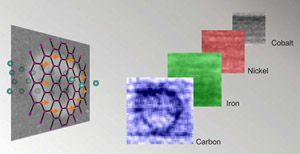Carbon is the element of life, without it we simply would not exist, despite the sci-fi penchant for silicon-based life forms. It is indeed a unique element with many apparently anomalous properties. However, one phenomenon that has not been observed unambiguously in carbon, until now, is magnetism. US and German researchers have used a proton beam and advanced X-ray techniques at the Stanford Linear Accelerator Center (SLAC) to put to rest finally any doubts about carbon’s elemental magnetism.
For many years, scientists suspected and perhaps even hoped to find a room-temperature magnetic form of carbon. The technological implications could be enormous, opening up a wealth of new applications in lightweight, adaptable, and flexible magnetic information storage systems, and other areas of microelectronics as well as providing a new material for the emerging field of microelectromechanical systems (MEMS), often referred to as lab-on-a-chip devices.

Magnetic Carbon
The possibility of truly magnetic carbon only appeared over the horizon about a decade ago, when meteorites were found to contain flecks of magnetized carbon. These specks of hope were, however, packed in close proximity to nickel, leading to the suspicion that the observed magnetism came from the nickel. In the past, research groups thought they had discovered magnetic carbon, explains Hendrik Ohldag, a staff scientist at the Stanford Synchrotron Radiation Laboratory (SSRL) at SLAC, Unfortunately, they realized later that they were misled by small amounts of iron, cobalt or nickel in their samples. These elements have been known to be magnetic since antiquity.
The potential for a carbon-based magnetic material rests not only on its ubiquity, but also the possibilities for manipulating it in countless ways from thin films to nanotubes that might be exploited in novel technology. With carbon, we know how to make things very small, said Ohldag. On the other hand we know a lot about how to process and store information using magnetism. This opens up the door for future studies that will lead to improved magnetism in carbon, which could one day lead to combining the ‘magnetic’ and the ‘carbon’ world. Harnessing the magnetic properties of carbon could one day revolutionize a range of fields from nanotechnology to electronics.
For instance, carbon nanodevices could be built one atom at a time, leading to miniaturized machines and lightweight electronics. Magnetism, which forms the basis of information storage and processing in computer hard drives, could be employed in novel ways in tomorrow’s electronic devices.
Magnetism is an ordering phenomenon, all atoms behave individually like tiny magnets because of the spin orientation of their electrons, and when enough of those magnetic spins, or moments, become aligned, the bulk material displays a measurable magnetic field. The electron spins of iron can be aligned very easily even at high temperatures, which makes it a ubiquitous magnetic material. Carbon’s electrons, in contrast, are so arranged that magnetization was thought theoretically unfeasible. However, bring nanoscopic pieces of carbon close to a definitively magnetic material such as nickel and it seems that transient magnetism on a small scale can be induced.
Now, Ohldag and his colleagues at the University of Leipzig in Germany have demonstrated that carbon’s transient magnetism can be made permanent at room temperature. The team used a proton to disrupt and align a portion of the electrons in samples of pure carbon, magnetizing tiny, measurable spots within the carbon. X-ray microscopy at ALS gave them images of the magnetized portions and to show for certain that no magnetic impurities were present in their samples.
At the moment only very small quantities of magnetic carbon can be produced, Ohldag told Spotlight, Also, the magnetic moment of such a spot is still very small. However, he explains that the technique allows them to understand how carbon’s electrons are affected by proton bombardment, which might help them make the moment bigger. We might even find ways to make carbon magnetic without proton bombardment, which is admittedly not very suitable for technological applications, By obtaining a better understanding what the protons really do we may find other more practical ways to modify carbon.
Further reading
Phys. Rev. Lett., 2007, 98
http://dx.doi.org/10.1103/PhysRevLett.98.187204
Dr Hendrik Ohldag homepage
http://www.stanford.edu/~hohldag/
Suggested searches
carbon
magnetism